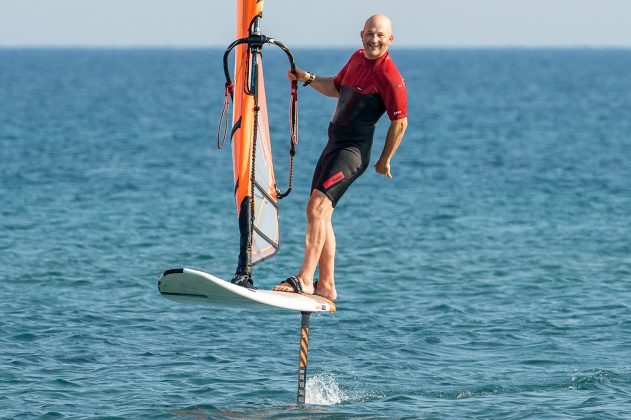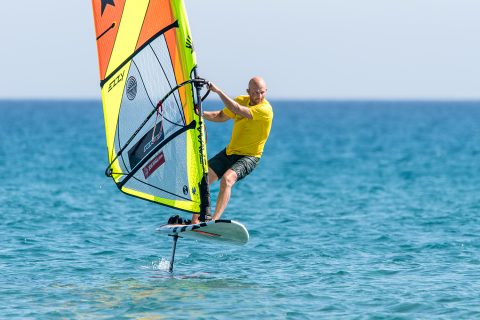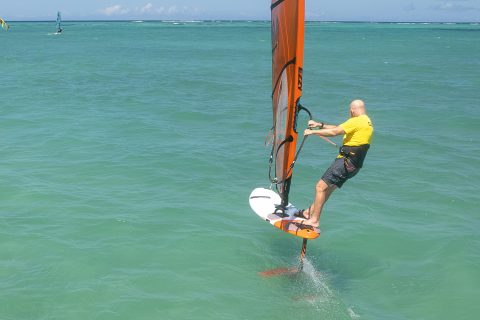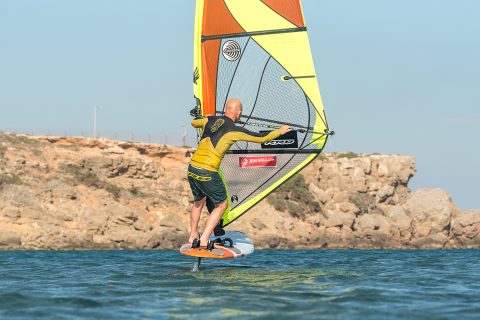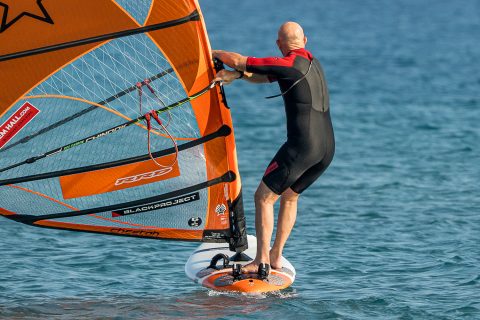JEM HALL
MOVE ON UP
MORE FOILING AROUND
Jem Hall: More foiling around
Jem Hall offers some awesome advice on how to improve your wind foiling technique.
PHOTOS –Eye Sea You Photo
Since learning to wind foil back in 2020, and writing my ‘Foiling Around’ article in the Nov. / Dec. 2020 issue, I have developed my skills in different conditions and on different boards. Wind foiling for me has been fun and a fantastic challenge, yielding also these additional benefits:
- Time on the water: I often go to the beach on an ok forecast and rig 5.8 and go wind foil and then go finning when it is too much wind for my foil set-up.
- Wind awareness: in lighter airs you need to see a gust in order to get up on the foil. Spotting gusts early when flying will ready you to lock the gear down, and also avoid more crashes!
- Tacks ticked: the first achievable transition in foiling is the tack, gybes are harder at the beginning. Therefore your tacks will inevitably improve. You can take these improvements into your finning and reap the rewards.
- C.U.P: this is Thinking Clearly Under Pressure, both in your stance and transitions. Dealing with all this on the foil means you can then be calmer and able to deal with more challenges while finning.
- Rig trim: as I have mentioned in other pieces, many people oversheet when getting going, this hangover from finning rears its head in foiling too. Learning to open the sail to both get planing and to get the foil up will help improve your rig trimming.
- Embracing the crash: you will crash when foiling, so getting comfortable with crashing can then be taken into your finning and help you improve it.
Stance
- Foiling into tacks are fun and a great skill builder; rake the rig back, as the hips swing forward, carve into the wind, and keep that nose up as far as you can.
- Pulling and pushing, down on front arm and front leg, with my back leg controlling the ride height and my body inboards to control the foil.
- A lot of areas need work in this shot. I need to look out of the turn to get the rig to the outside, so my hips can go to the inside, and my back foot is simply not far enough across to keep the carving going through and out of the gybe!
Here are some reflections on your stance for foiling:
- Get it up: get it up both unhooked and hooked in. I find it easier to get up with less power, unhooked and when I have more power I can get up on foil hooked in. Both will require you to pump efficiently and remember to not oversheet.
- Pull and push: pull down a lot on the front arm, as you push down on a strong front leg. If you have less power in the sail, reduce your front arm and leg forces to stop the nose dropping.
- Open and push: open the sail slightly and push down on the back leg in lulls. This will stop the nose dropping and keep you up, it is counter intuitive at first. I often shift my back foot back to do this, made easier with no footstraps, or no back footstraps.
- Line vs. speed: you can really fly upwind on a foil, so as you do this, start to experiment between carrying a higher line upwind, or going less high and going faster. It has great skills transfer to finning.
- Be decisive: the foil likes clear instructions and feedback, if you dab at it or switch off for just a second, there will be repercussions. This is what makes foiling great, as it is so engaging.
- Cruise: if you are given too much power or going too fast, you can just sheet out a little, keeping the downforce on, and cruise along as you get your focus, courage and breath back. Then you can go again and look to boost some higher top speeds.
Gybe stages
A lot of the stages of the foil gybe are similar to the fin gybe, but there are some subtle differences:
- Open the sail, get the hips to the inside so you can keep the turn going as you move towards the foot change. Be soft on that back knee to stop the nose popping up. Any arm bending and back leg pushing here and it’s off you go!
- Switch the new front foot into the strap and get stable clew first and aim to maintain staying up on foil by sheeting out on the mast hand. Focus on keeping the rig away to give you some power so it can keep you up on the foil. You will get more accustomed to the required pressure on the back foot; either more to keep the nose up, or less to keep it down. If you touch down, then just get stable clew first, have your weight back and then rotate the rig and pump to get back on foil again.
- Rotate the rig and keep looking forward. You may touch down here, but if you have speed you can pop back up with some back foot pressure. Pressure on your heels as you do this will help you come back to more across the wind. You do not have to rush to grab the rig with the back hand here. Sometimes I am coming out of my gybe on the foil and only have my front hand on the boom as I send the rig forwards.
- Back hand: a foil gybe is different in that I have found it is better to move the back hand late in approach, as opposed to the early movement in a fin gybe. This is due to the sail being so light and oversheeting drops the nose. Once you start carving you really need your back hand back to get the rig forward, then to open the rig, and then to the outside of turn so you can keep the board turning and nail the foot change.
- Scissor: scissor downwind a lot for the foil gybe to get your speed up so the foil is stable and has momentum.
- Height: get your ride height down, in order to give you more room for error.
- Front arm: if you have back straps on your foil board, when coming out of them, don’t pull down as hard on the front arm as you would when finning. You almost have to let the nose come up a little bit as you take the back foot out.
- Rig forward: get your rig forward and relatively open, as your sail is so light due to your speed relative to the wind.
- Pressure: the foil is quite responsive, so don’t go in as heavy with your carving pressure as you might on a big freemove board.
- Back foot: you can carve out more on the back foot in the foil gybe exit as you are looking to keep the nose up. If you are too far forward, like you might be in a fin gybe, then the nose will bury and bury fast.
Common Mistakes
- Not bearing away enough to get going, which gets the water flowing over the foil so it generates lift to assist in getting it up.
- Not getting into the straps early enough so you can get back to push down to lift the foil
- The sail is light a lot of the time so it is so easy to oversheet, so be aware of this, either as you get going, or when there is less wind, or when in lulls, or when gybing.
- Being too tentative in the gybe. Go for it and keep the turn going.
It’s fun to practice wave riding on the foil, on flat water or on small swells.
- Bottom turn: Get the rig forward and open, as you scissor and then carve. Getting comfy at this will boost your foil gybe entrances, and your ability to control and maintain ride height.
- Top turn: Keep the sail open, bring it forward, look upwind, keep the ride height stable with your back foot pressure and carve off your heels. You can do many of these turns, they are fun and really build your skills.
Kit and tuning:
Board choice: I mixed up my learning on both a foil ready freemove board and the short dedicated RRD foil board, the Pocket Rocket. I liked both, but I enjoyed feeling different foot positions on the Pocket Rocket without straps attached, and I loved its shorter length too.
Foil choice – I feel it can be best to learn on a low aspect, early lift and easy to gybe foil, and then go to the faster set-up afterwards, if you wish to. The early lift foil was what I went with, as I wanted to get out in lighter winds and with smaller sails. There are lots of options on foil types and designs, so think about what would favour your style, the conditions you want to get out in and what sort of wind foiling you want to do.
Straps: I enjoy no straps on my Pocket Rocket (short foil board), and when using my FreeMove board I take off the back straps so I can my get back foot back for getting up, and for gybing and also as getting in and out of the back strap lead to some of the most crashes for me.
Sail tuning: I tuned a lot in the water, as it is a faff to get in and out with the foil. More outhaul as soon as I was too powered up, and less outhaul for underpowered.
Mastfoot: moving the mastfoot back (gets foil up) and forward (brings nose down) by a few cm made a big difference.
Knuckle U.J.: this is easier for attaching the rig to your foil set-up in shallower water. It can also be loosened easily with the rig in the water, so you can move the mastfoot back or forward.
Ezzy sails, RRD (boards, wetsuits & softwear), Chinook & Black Project fins sponsor Jem Hall. Get him live and direct on one of his highly acclaimed coaching holidays – check out his website www.jemhall.com for details. You can also follow him on twitter / Facebook / Instagram.


